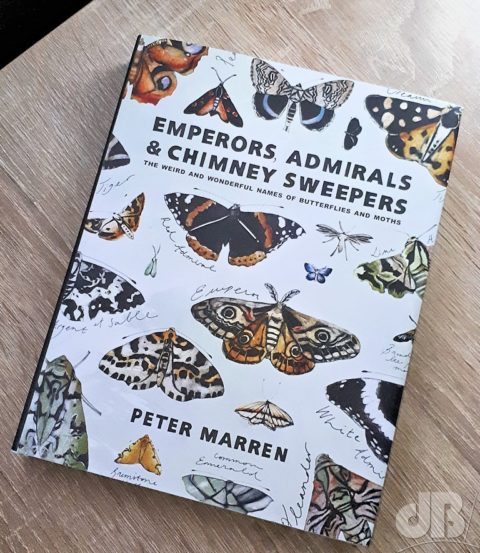After much anticipation, Peter Marren’s new book – Emperors, Admirals & Chimney Sweepers (The weird and wonderful names of butterflies and moths) recently landed on my desk for review. One of the things I find most fascinating about the lepidoptera is their nomenclature, both the common names – such as Angle Shades, Lime-speck Pug, and Red Admiral, but also the scientific binomials including Aglais io, Autographa gamma, and Polygonia c-album.
Indeed, so fascinated was I that I put together a book proposal to write about how the butterflies and moths all got their names…but Marren had already beaten me to it and has done a far better job in writing about them than I ever could.
He explains the origins of almost every species you’re likely to come across in the UK. He tells us why the pug moths are called pugs (yes, it is to do with their resemblance in some characteristics to the flat-faced dogs). He explains that The Sprawler moth has a “star-gazing” caterpillar names after the Italian astronomer, Cassini. There’s also proof as to why the Common Wainscot is so named and it is indeed for the plain wooden panelling, as Mrs Sciencebase suspected when I presented that very moth in a pot a few days ago!
The infamous Death’s Head Hawk-moth, once a harbinger of doom, is in there as is the Jersey Tiger, the Emperor, and the Brimstone (both butterfly and moth). There are plenty of carpets too…which was never an insult as back in the day when these leps were named, having a carpet was a luxury, naming a patterned animal that recalls an elaborate carpet was therefore a compliment.
An excellent book for moth-ers and butterfly enthusiasts in the Little Toller Field Guide series. Highly detailed index makes it easy to look up the latest species that appears in one’s trap or is spotted in the garden our elsewhere – Cinnabar, White Ermine, Light Brocade, Garden Pebble, Waved Umber, Mottled Rustic and so on. There are well over 2500 species of lepidoptera in the UK and a few migrants and vagrants. Keep up to date with my own personal sightings and their names in my Mothematical Gallery.
Incidentally, there was a rumour that the proper name of the Red Admiral butterfly, Vanessa atalanta, is the Red Admirable. Even novelist and lepidopterist Nabokov insisted on this point. Marren discusses the etymology and in an update for the paperback, suggests that both words were probably in use very early.
